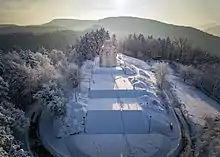Banj brdo
Banj brdo (Serbian Cyrilic: Бањ брдо, translated as Banj hill), before known as Šehitluci (Serbian Cyrilic: Шехитлуци) is a 431 meter hill and tourist and recreation place in Banja Luka, part of Bjeljavina mountain.

On top of the hill there is Monument to fallen Krajina soldiers, work of Antun Augustinčić dedicated to dead soldiers of People Liberation War in Bosanska Krajina and it is possible to see whole city from that place.[1] Serpentine road on Banj brdo that leads to the monument is made in years 1932 and 1933 on which today small tourist bus is circulating between Day of the City of Banja Luka (April 22) and September 30.[2][3]
Name of the hill
After War in Bosnia, the name of Šehitluci was changed into Banj brdo because of etymology of old name. Word šehitluci is derived from Turkish word šehid, that means Muslim soldier. Also there are some legends about name Šehitluci. The name is linked with Battle of Banja Luka 1737 when some Muslim soldiers were beheaded and they ran from Hiseta to today Banj brdo with their heads in hands. They came to one spring were they died and it is considered that they were buried on top of the hill where it was a turbe - above the surface closed Muslim grave building. On same place rule of Vrbas banovina build a pyramid as monument for those who died and from that time the hill had name Šehitluci.[4]
See also
References
- "SPOMENIK PALIM KRAJIŠNICIMA-BANJ BRDO" (in Serbian). Banja Luka Tourist Organization.
- "Detalji iz prošlosti Banjaluke koje vjerovatno niste znali" (in Serbian). Alternativna Televizija. 2016-01-13.
- "Панорамским бусом на Бањ брдо" (in Serbian). City of Banja Luka Official Site. 2019-04-03.
- "Spomenik Krajišnicima palim u Narodnooslobodilačkoj borbi" (in Serbian). Banja Luka Official Site. 2019-04-03.